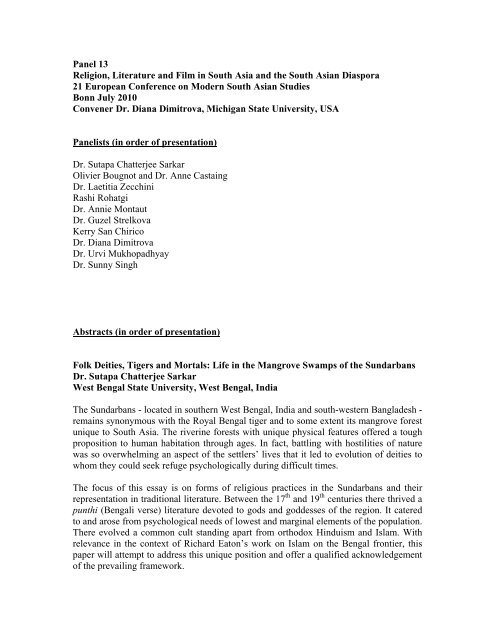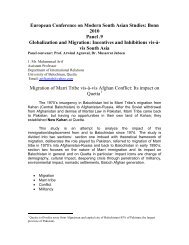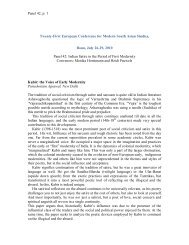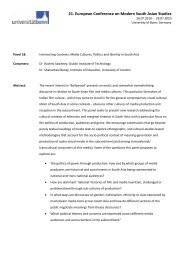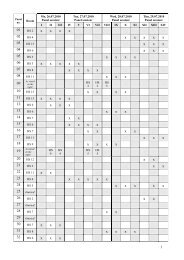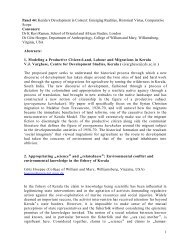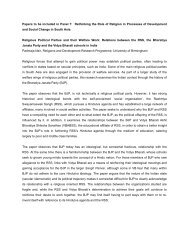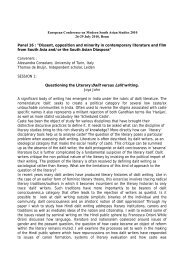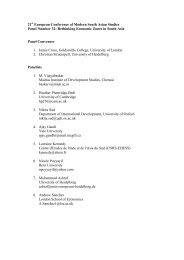Panel 13
Panel 13
Panel 13
Create successful ePaper yourself
Turn your PDF publications into a flip-book with our unique Google optimized e-Paper software.
<strong>Panel</strong> <strong>13</strong><br />
Religion, Literature and Film in South Asia and the South Asian Diaspora<br />
21 European Conference on Modern South Asian Studies<br />
Bonn July 2010<br />
Convener Dr. Diana Dimitrova, Michigan State University, USA<br />
<strong>Panel</strong>ists (in order of presentation)<br />
Dr. Sutapa Chatterjee Sarkar<br />
Olivier Bougnot and Dr. Anne Castaing<br />
Dr. Laetitia Zecchini<br />
Rashi Rohatgi<br />
Dr. Annie Montaut<br />
Dr. Guzel Strelkova<br />
Kerry San Chirico<br />
Dr. Diana Dimitrova<br />
Dr. Urvi Mukhopadhyay<br />
Dr. Sunny Singh<br />
Abstracts (in order of presentation)<br />
Folk Deities, Tigers and Mortals: Life in the Mangrove Swamps of the Sundarbans<br />
Dr. Sutapa Chatterjee Sarkar<br />
West Bengal State University, West Bengal, India<br />
The Sundarbans - located in southern West Bengal, India and south-western Bangladesh -<br />
remains synonymous with the Royal Bengal tiger and to some extent its mangrove forest<br />
unique to South Asia. The riverine forests with unique physical features offered a tough<br />
proposition to human habitation through ages. In fact, battling with hostilities of nature<br />
was so overwhelming an aspect of the settlers’ lives that it led to evolution of deities to<br />
whom they could seek refuge psychologically during difficult times.<br />
The focus of this essay is on forms of religious practices in the Sundarbans and their<br />
representation in traditional literature. Between the 17 th and 19 th centuries there thrived a<br />
punthi (Bengali verse) literature devoted to gods and goddesses of the region. It catered<br />
to and arose from psychological needs of lowest and marginal elements of the population.<br />
There evolved a common cult standing apart from orthodox Hinduism and Islam. With<br />
relevance in the context of Richard Eaton’s work on Islam on the Bengal frontier, this<br />
paper will attempt to address this unique position and offer a qualified acknowledgement<br />
of the prevailing framework.
The texts dealt with here are the following:<br />
i) The Raimangal eulogizing the tiger god Dakshin Ray was written in the year 1686 by<br />
Krishna Ram Das. Later it was edited and published by Satyanarayan Bhattacharya on<br />
behalf of the Calcutta University. There is also an incomplete undated manuscript of the<br />
Raimangal by Rudradev. This was published in the Sahitya Prakasika, Vol. V, Dwadash<br />
Mangal, ed. Panchanan Mondal, Santiniketan, 1966.<br />
ii) The Ghazi-Kalu-Champavati-Kanyar-Punthi was composed by Abdur Rahim. The<br />
date of compositon is unknown. But reference to the sub-division in which the author was<br />
born makes it clear that the text could not have been written before the Mutiny. It was<br />
presumably a late nineteenth-century punthi.<br />
iii) The Banabibi Jahuranama is about the mother goddess Banabibi. This was composed<br />
by Banayuddin in the year 1877. There is another version of the tale by Marhum Munshi<br />
Muhammad Khater entitled Banabibi Jahuranama written in 1287 B.S., Kartik, i.e. 1880.<br />
These texts are all written in simple verse. It is well known that the people chanted some<br />
verses before they entered the forest so that no danger would befall them.<br />
Defining our Enemy: National Consciousness and Communal Persistence in Hindi<br />
and Bengali Literature<br />
Olivier Bougnot & Dr. Anne Castaing<br />
INALCO – Paris, France<br />
This paper aims at questioning the persistence and the transformation of communal<br />
reflexes at work in Hindi and Bengali literature from the mid- XIXth century, examining<br />
the close and paradoxical links existing between the building of a nation based on unity<br />
and the stigmatization or the evacuation of the Muslim. If some recent works identify<br />
explicit communalist discourses in XIXth century literature (Bankim Chandra Chaterjee,<br />
Harishchandra Bhartendu) and early XXth century literature (Maithili Sharan Gupt), this<br />
paper is concerned by the transformation of these “explicit discourses” into “implicit<br />
discourses”, as occurred from the mid-1920’s, when they are contradicted by the unitary<br />
fervour inspired by Gandhi and the Congress Party. Simultaneously, it explores the<br />
crystallisation of the feeling of “enmity” brought about by Partition, which converted a<br />
former “stigmatized” Muslim into a “guilty” Muslim. In this regard, Rabindranath<br />
Tagore’s and Agyeya’s stories will display the ambivalence between the authors’ explicit<br />
discourses and the text’s implicit communalism.<br />
2
Bhakti in the modern mode: the filiations claimed by contemporary Indian poetry<br />
Dr. Laetitia Zecchini<br />
INALCO- Paris, France<br />
The paper aims at exploring how contemporary Indian poetry in English and in Hindi<br />
translates, both literally and figuratively, the bhakti tradition and the bhakti texts. The<br />
paper will focus on the reinterpretation of the two towering figures of Tukaram and Kabir<br />
and their relevance in the works of Kedarnath Singh in Hindi, Arun Kolatkar, Dilip<br />
Chitre or Arvind Krishna Mehrotra in English. What are the terms of this dialogic<br />
interaction between medieval and modern voices? What affinities with the bhakti poets,<br />
whose voices have often been reconstructed as subaltern, do contemporary poets choose<br />
to foreground? Is the religious dimension lost or silenced to "this-wordly"<br />
preoccupations? The central experience of alienation and otherness in bhakti poetry, the<br />
directness and the ecstacy of these voices, their irreverence, inappropriateness and<br />
resistance to a "dividable" truth, the marginality, itinerancy and unhomeliness of the sants<br />
and varkaris, but also their restless experimentation with language seem particularly<br />
significant to contemporary poets.<br />
The Construction of a New Mauritian Hinduism in the Poetry of Abhimanyu<br />
Unnuth<br />
Rashi Rohatgi<br />
SOAS, London, UK<br />
Abhimanyu Unnuth is the most well known Mauritian poet writing in Hindi. His works<br />
are a response to and an expression of Indo-Mauritian self-understanding in the years<br />
after the struggle for independence (obtained in1968), during which unification of the<br />
community under the auspicies of religion and language was instrumental in obtaining a<br />
largely peaceful independence. The poems grapple with the sufferings faced by the<br />
community's laboring ancestors as well as the meaning that such suffering can have in<br />
light of the shortcomings Unnuth witnessed in Mauritius in the 1980s: poverty, hunger,<br />
exploitation, and political obfuscation. Classically Hindu concepts- questions and<br />
characters from the epics and the puranas- are juxtaposed with post-colonial questions of<br />
what heaven and higher power mean. Through these juxtapositions, Unnuth comes to<br />
conclusions about what his Hinduism and the Hinduism of a new generation of Indo-<br />
Mauritians can be. In the end, his choice of language- Hindi, the religious vernacular for<br />
Indo-Mauritian Hindus but the daily language of very few- renders him less effective<br />
than writers in English, French, or Creole at reaching his audience, but, I would argue,<br />
more effective at illustrating the power of religion not only to react against traditional<br />
understandings of Hinduism on the island but to transcend them. Exploring the way<br />
Unnuth has, with his re-membrance of the Mauritian laboring soul, redefined Hinduism<br />
for a new generation of Indo-Mauritians, brings a new dimension to Unnuth's poetry for<br />
non-Mauritian readers.<br />
3
On Two Interpretations of Marginality in Contemporary Literature and Art<br />
Dr. Annie Montaut,<br />
INALCO, Paris, France<br />
The very notion of margin is intrinsically ambivalent..On one hand, the now prevailing<br />
meaning of the term, used since the early eighties as a constructive concept by the various<br />
trends of cultural studies, takes for granted a vision of the world society as a field once<br />
structured around a more or less stabilized centre reigning over its voiceless (yet not<br />
devoid of agency) margins, the latter more and more claiming for a de-centred identity in<br />
a general struggle for legitimacy. Transposed on the South Asian scene, such an agonistic<br />
model seems particularly fit for analysing the so-called ‘dalit’ literatures, particularly in<br />
Indian languages, as well as radical works voicing a claim against high cast/class<br />
hegemony. On the other hand, the notion of marginality is traditionnally connected with<br />
the figure of the sadhu right from the early shastras. A paradox admitted by the<br />
anthropologist Louis Dumont and made central by Madeleine Biardeau’s reading of<br />
Hindu society. The sadhu, who stands at the indeterminable limes of society, both inside<br />
and outside of it, the true ‘tatasth’ (lit. on the river bank: belonging to neither here nor<br />
there) is at the same time the one outside the varnas, beyond the whole social<br />
architecture, and the one embodying the very aim of every section of the society and the<br />
truth of society itself as its raison d’être (true knowledge and true speech) – similarly<br />
moksha has been interpreted by some as the cardinal purushartha, in the continuity yet<br />
beyond and outside the three others.<br />
Both meanings seem to be radically opposed, the first one echoing an agonistic model of<br />
society, the second one an inclusive model. I will illustrate both meanings with four<br />
examples (respectively Mohandas Naimisharay’s ‘historical’ novel Virânganâ Jhalkârî<br />
Bâi and Ritwick Ghatak’s last movie vs Jainendra Kumar’s Resignation (Tyag patr), and<br />
K.B. Vaid’s There is no other (Dusra na koi), and attempt to show that the opposition<br />
may not be so radical.<br />
HINDU GODDES OR MUSLIM PERI – A HEROINE OF Ph.RENU’S “TIISRII<br />
KASAM ARTHAAT MAARE GAYE GULFAAM” (STORY AND FILM)<br />
Dr. Guzel Strelkova<br />
Institute of Asian and African Countries, Moscow State University<br />
Moscow, Russia<br />
The paper is based on a story written by prominent Hindi writer Phanishvarnath Renu<br />
“The Third Vow or Killed Gulfam” and its screen version. The main heroine, Hirabai, -<br />
an actress of Nautanki Theater – is perceived from different points of view (by the<br />
narrator and the story’s main and second plan heroes). The aim of the paper is to discuss<br />
to which extend religious, cultural, literary and commonplace perceptions of the one and<br />
the same object may differ, how religion and myth can construct perception and<br />
description of the heroine, how it is performed in the story and the film. The both – the<br />
story and the film - show interaction and interference on the “border” between “right and<br />
4
wrong”, “good or bad”, “legal and illegal”, “equal or subaltern”. As a result, the heroine<br />
and the hero act and balance on the margins.<br />
“Tiisri kasam arthaat maare gaye Gulfaam” is considered to be the classics of<br />
contemporary Hindi literature. It deals with a popular in dastan poetics motif of a love<br />
between an earthy prince and a fairy which was used in the first Urdu play “Indra Sabha”<br />
(1853) and presented the so called “Hindu-Muslim synthesis”. P. Renu brilliantly applied<br />
this motif and at the same time he used Hindu religion and myth. It helped to the writer to<br />
create a plot, characterize the heroine, transmit international folklore and literary tradition<br />
and reach some other tasks (including ideological ones).<br />
The main attention of the paper will be paid to the margins on which the heroes of the<br />
story coexist (mainly in the world of Hindu and Muslim religions and culture, rural and<br />
urban style of life). Finally the hero takes a vow, meaning that he avoids marginality and<br />
continues to belong to his own social, religious and cultural strata. The heroine also does<br />
not change her usual way of life. But a few days they spent together changed their life. In<br />
this way the story and the film confirmed that a margin is as much important as a norm<br />
and it is necessary to discuss and consider them both – and try to realize their cross<br />
influence.<br />
Dharma, the Dharmik, and the Religious Other in Hindi Popular Cinema:<br />
Exegeting Films as Religio-Cultural Texts<br />
Kerry PC San Chirico<br />
University of California-Santa Barbara<br />
Santa Barbara, California, USA<br />
Whether it to be the samajik (“social”/popular) film or the specifically dharmic<br />
(religious) film, the connection between religion and film has been significant since the<br />
birth of Indian popular cinema in the early 1900s. The popular film, in particular, has<br />
always born the marks of dharma either in content or form. While the genre is never<br />
referred to as the “Hindu social,” a Hindu worldview is in fact presented. At the same<br />
time, it is no coincidence that the dominant ideology of the social/popular genre has long<br />
mirrored the dominant ideology of the nation-state. Thus, Indian popular film, including<br />
the Hindi variant known since the 1990s as Bollywood, provides the exegete a religiocultural<br />
text of modern, mostly middle-class India, exhibiting ideological and sectarian<br />
tensions, imaginaries, hopes, and nightmares (in the form of bhoots, prets, and<br />
Pakistanis). What, then, do recent films tell us about the role of the religious other in the<br />
contemporary Indian imaginary? This paper examines the role of dharma and the dharmik<br />
in Hindi popular film before demonstrating the deep ambivalence present in filmic<br />
representations of India’s religious minorities. The paper is happily accompanied by<br />
Hindi film clips to be translated by the author. These films include Guide (1965),<br />
Imtihaan (1974) Amara, Akbar, Anthony (1977), Fanaa (2006), and Kurbaan (2009).<br />
5
Religion and ‘Otherness’ in Bollywood Film<br />
Dr. Diana Dimitrova<br />
Michigan State University<br />
East Lansing, Michigan, USA<br />
This paper will explore the representation of the notion of ‘otherness’ in Bollywood film.<br />
I will focus on the interpretation of the West and of the religious ‘other’ in film as well as<br />
on issues of diaspora and globalization. Some of the most recent Bollywood films that I<br />
will discuss are: Lagan (The Rent on Land), Dil cahta hai (The Heart Wants), and Ham<br />
Dil De Cuke sanam (I Have Already Given My Heart Away), Dilwale Dulhane Le<br />
Jayenge (The Bridegroom will Take away the Bride) and Kuch kuch hota hai (Something<br />
Happens). It is characteristic of the films that they deal with aspects of modernity,<br />
westernization and globalization in order to assert nationalistic Hindu identity that is<br />
different, “other,” and often traditional and conservative. The paper will examine the<br />
ideological implications of the representation of religion and ‘otherness’ and will also<br />
address questions of orientalism, diaspora and globalization.<br />
Imagining the Powerful ‘Other’: Representations of Razia Sultan<br />
Dr. Urvi Mukhopadhyay,<br />
West Bengal State University,<br />
West Bengal, India<br />
Razia bin Iltutmish (1236-40 AD) was perhaps the first woman in the Islamic world who<br />
exercised her political power from not behind the scenes, but actually as a ruler. Though<br />
the medieval sources have scarcely referred to this unusual phenomenon, an interest<br />
about this atypical ruler is quite rampant in the Orientalist writings since days of the<br />
colonial period. Romantic tales about Razia and her ‘fatal’ relationship with her ‘black’<br />
‘slave’ became a staple for historical romances as early as in 1836 where the focus was<br />
on ‘tragic’ tales of medieval lives under the oppressive conditions of ‘despotic’<br />
governance and ‘bizarre customs’. The image of Razia became more intriguing as it<br />
could generate the seductive attraction of the oriental pleasures by portraying a woman at<br />
the centre of the courtly intrigues. This imagery drew a striking resemblance with widely<br />
portrayed image of another oriental female ruler Cleopatra, whose representation became<br />
the reservoir of polemical ‘other’ of the occidental male self in popular literature and<br />
films. The feminine image of Razia, however, stirred a more complex emotion during the<br />
nationalist movement, when the woman with power to rise against the ‘demonic’ rule of<br />
the foreign power was evoked to uphold the nationalist self-esteem. At least three<br />
versions of Razia’s reign were made on screen during three different historical periods:<br />
1924, 1961 and 1983 respectively.<br />
This paper would like to trace the popular representations of Razia, especially on screen<br />
by which the politics of representation of the controversial stereotypes such as ‘oriental<br />
despot’, ‘female ruler’ and ‘Islamic woman’ could be re-invoked. The focus will be on<br />
three different films made on Razia named Razia Begum (1924), Razia Sultan (1961) and<br />
6
Razia Sultan (1983) which will hopefully reveal the complex relationship between<br />
history and popular imaginations that changed along with time<br />
Remembering Bhangashvana: Towards an Inclusive, Fluid Construction of Gender<br />
and Sexual Identities as the Basis for Representation in Commercial Hindi Cinema<br />
Sunny Singh<br />
London Metropolitan University<br />
London, UK<br />
In the Mahabharata, Bhisma explains to the Pandavas that only Bhangashvana would<br />
know whether men or women experience greater sexual pleasure as he alone of all<br />
humans had lived as both a man and a woman. The story is not alone in Indic classical<br />
texts which abound in gender and sexual fluidities. Indeed, one may argue that gender<br />
roles and archetypes, and the part they play in sexual identity and desire is not the binary<br />
formulation of the Semitic traditions, but rather based on a spectrum of gender and sexual<br />
identities that may simultaneously inhabit multiple socio-cultural spaces and assert<br />
multiple and fluid manifestations.<br />
This paper examines the ways gender and sexuality are constructed in popular Hindi<br />
cinema as part of a ‘fluidity spectrum,’ creating images that traverse limiting ideals of<br />
masculinity and femininity and provide spaces for assertion of sexual identities that need<br />
not fit into limiting/limited socio-psychological constructs. The paper considers a range<br />
of films of the past forty years, including Rafoo Chakkar (1975), Razia Sultan (1983),<br />
Daayra (1996), Shabnam Mausi (2005), My Brother Nikhil (2005) and Dil Bole Hadippa<br />
(2009), exploring not only films that foreground issues of gender and sexuality but also<br />
those that seem to treat non-heteronormative desires in subversive, diverse and inclusive<br />
ways.<br />
As part of this analysis, this paper attempts to argue that perhaps new theoretical<br />
formulations of sexual and gender identities are needed for cinema and literature in India<br />
that go beyond constructions of “queerness” and/or “camp” in order to provide a more<br />
culturally-relevant explanation of gender and sexuality that are based on fluidity and<br />
inclusiveness, rather than binary exclusions.<br />
7


